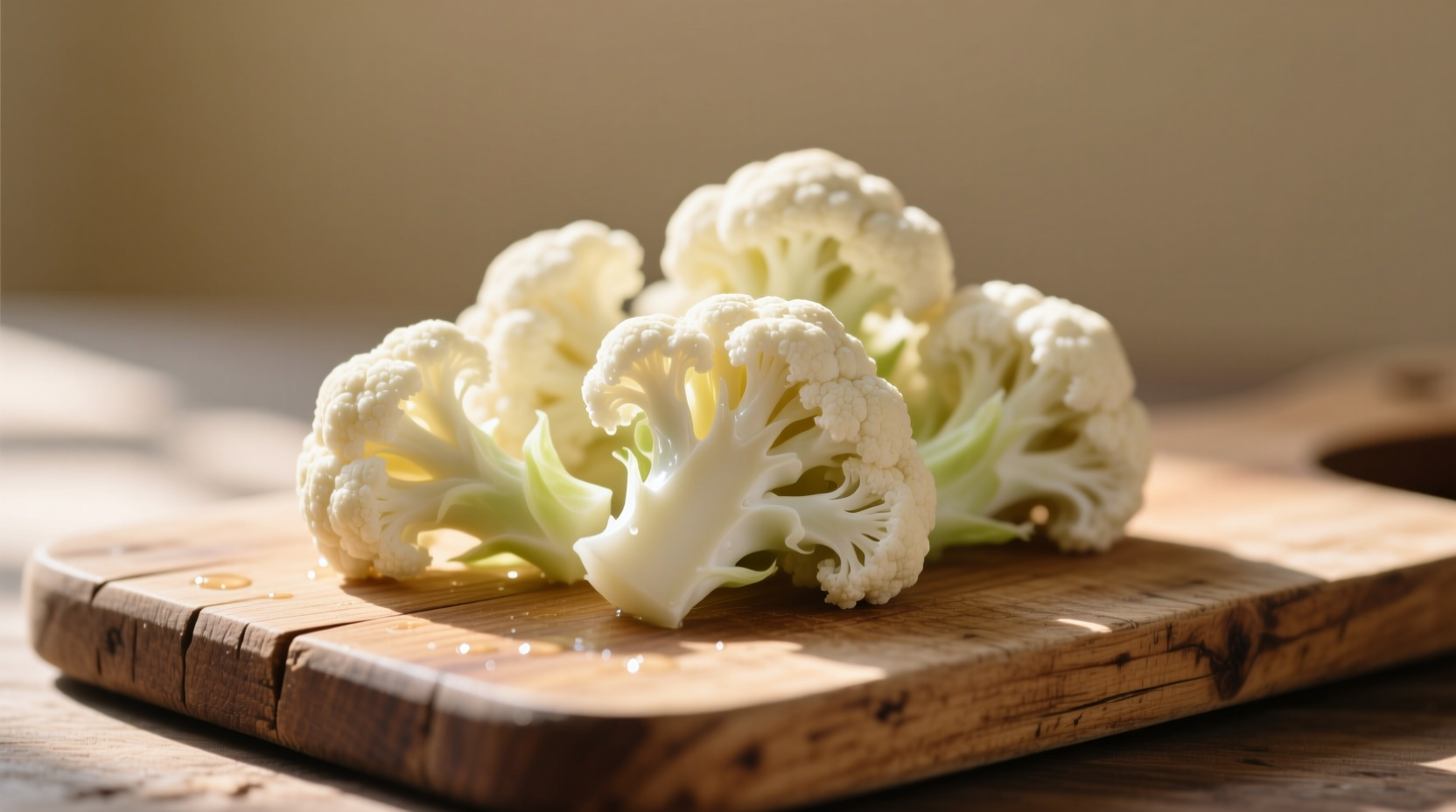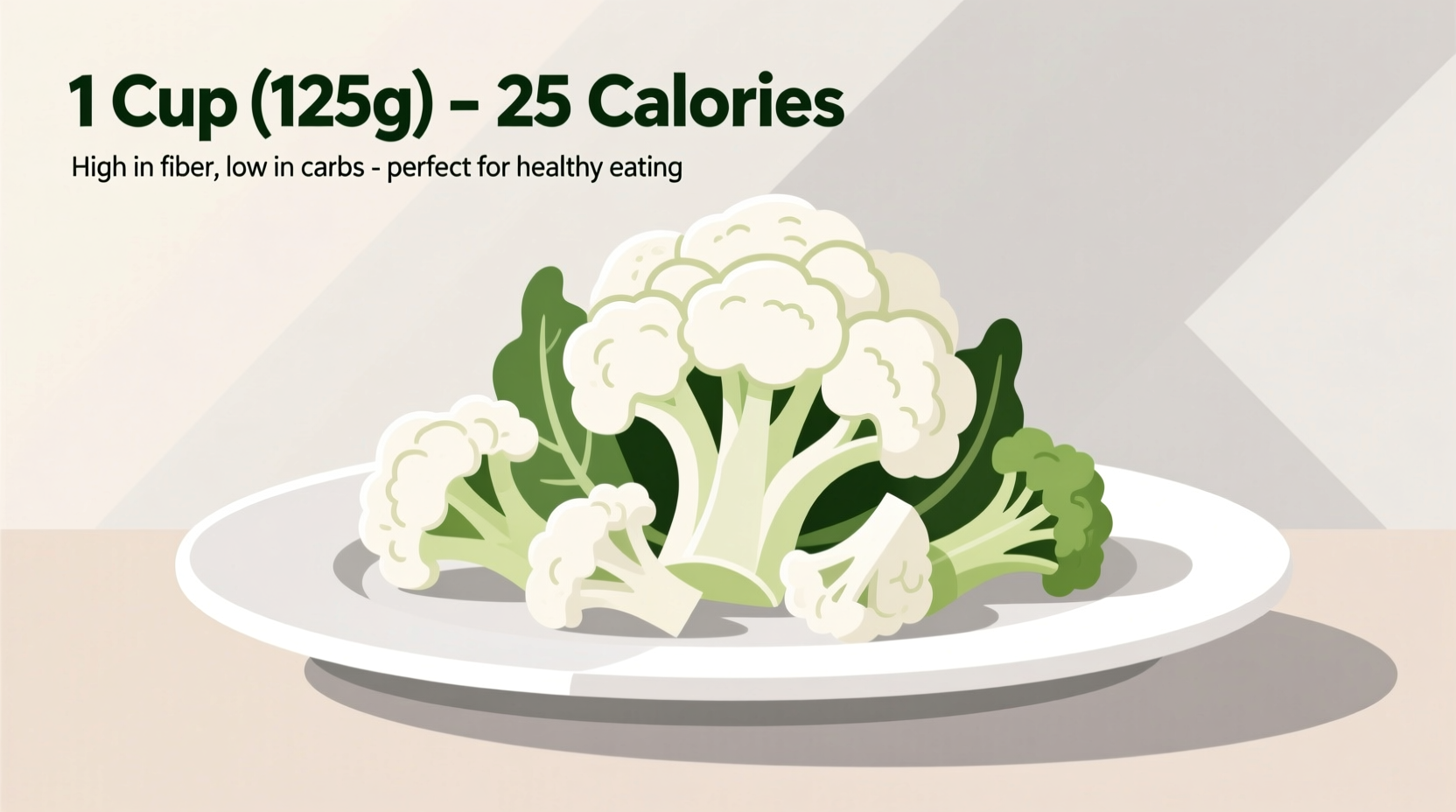Understanding the precise nutritional value of everyday foods helps make informed dietary choices. Cauliflower's remarkably low calorie count combined with its impressive nutrient density explains why it's become a staple in health-conscious kitchens worldwide. Whether you're tracking macros, managing diabetes, or simply eating healthier, knowing these facts puts you in control of your nutrition.
Complete Nutritional Breakdown of 1 Cup Cauliflower
According to the USDA FoodData Central database, a standard serving of raw cauliflower (1 cup chopped, approximately 100g) delivers these essential nutrients while keeping calories remarkably low:
| Nutrient | Amount | % Daily Value* |
|---|---|---|
| Calories | 25 | 1% |
| Total Fat | 0.3g | 0% |
| Carbohydrates | 5g | 2% |
| Dietary Fiber | 2g | 7% |
| Sugar | 1.9g | - |
| Protein | 1.9g | 4% |
| Vitamin C | 48.2mg | 77% |
| Vitamin K | 15.5mcg | 13% |
| Folate | 57mcg | 14% |
*Percent Daily Values based on a 2,000 calorie diet. Source: USDA FoodData Central
How Preparation Methods Affect Cauliflower Calories
The calorie count changes slightly depending on how you prepare cauliflower. Many people wonder does cooking cauliflower increase calories - the answer depends on your cooking method:
- Raw: 25 calories per cup (100g)
- Steamed: 28 calories per cup (water content changes slightly)
- Roasted: 30-35 calories per cup (concentrates natural sugars)
- Riced: Approximately 25 calories per cup (same as raw)
- Cheesy cauliflower mash: Can range from 80-150 calories depending on added ingredients
When tracking calories in cooked cauliflower per cup, remember that cooking methods using oil, butter, or sauces significantly increase the calorie count, while dry-heat methods like roasting have minimal impact.

Why Cauliflower's Calorie Profile Stands Out
Compared to other common vegetables, cauliflower offers exceptional nutritional value for its calorie count. This makes it particularly valuable for those following low calorie vegetable options for weight loss strategies. Let's examine how cauliflower stacks up against similar vegetables:
- Broccoli: 34 calories per cup - slightly higher in calories but similar nutrient profile
- Celery: 16 calories per cup - lower calorie but significantly fewer nutrients
- Carrots: 52 calories per cup - higher in natural sugars and calories
- Zucchini: 20 calories per cup - comparable calorie count with different nutrient profile
What makes cauliflower special is its combination of extremely low calories with high concentrations of vitamin C, vitamin K, and choline - a nutrient important for brain health that many people don't get enough of. This nutrient density per calorie ratio is why nutritionists consistently recommend it.
Practical Applications for Meal Planning
Knowing the exact calories in 1 cup of cauliflower helps you make strategic choices in meal planning. Here's how to leverage this information:
For Weight Management
Substituting higher-calorie ingredients with cauliflower can create significant daily savings. For example:
- Replace half the potatoes in mashed potatoes with cauliflower (saves ~100 calories per serving)
- Use cauliflower rice instead of white rice (saves ~150 calories per cup)
- Create pizza crust with cauliflower instead of traditional dough (saves ~200 calories per serving)
For Blood Sugar Management
With only 5 grams of carbohydrates per cup and 2 grams of fiber, cauliflower has a minimal impact on blood sugar. This makes it an excellent choice for those managing diabetes or following low glycemic index vegetable options.
Maximizing Nutrient Absorption
To get the most from cauliflower's nutrients:
- Eat some raw for maximum vitamin C retention
- Lightly steam or roast to enhance absorption of certain antioxidants
- Pair with healthy fats (like olive oil) to increase absorption of fat-soluble vitamins
Common Misconceptions About Cauliflower Calories
Several myths persist about cauliflower's nutritional value. Let's clarify with evidence from the National Center for Biotechnology Information:
- Myth: All preparation methods keep calories the same
Fact: While the vegetable itself doesn't change calorie content, added ingredients during cooking significantly affect the final count - Myth: Frozen cauliflower has fewer nutrients
Fact: Frozen cauliflower often retains more nutrients than fresh that's been stored for several days - Myth: The core and leaves aren't nutritious
Fact: These parts contain similar nutrients to the florets and should be used to reduce food waste
Incorporating Cauliflower Into Your Diet
With its mild flavor and versatile texture, cauliflower adapts beautifully to numerous preparations. Try these simple approaches to enjoy low calorie cauliflower recipes that maximize nutritional benefits:
- Raw: Enjoy florets with hummus or yogurt-based dips for a crunchy snack (adds minimal calories)
- Steamed: Lightly steam and toss with lemon juice and herbs for a simple side dish
- Riced: Pulse in food processor and sauté with garlic for a low-calorie rice alternative
- Roasted: Toss with minimal olive oil and roast at high heat for caramelized flavor without excessive calories
- Blended: Puree cooked cauliflower with low-sodium vegetable broth for a creamy soup
Remember that portion control matters even with low-calorie foods. While how many calories in a cup of cauliflower is impressively low, adding high-calorie sauces or cooking in excessive oil can negate these benefits.
FAQs About Cauliflower Nutrition
How many calories are in 1 cup of cooked cauliflower compared to raw?
One cup of raw cauliflower contains 25 calories, while the same volume of cooked cauliflower typically contains 28-35 calories depending on preparation method. Steaming adds minimal calories (28), while roasting concentrates natural sugars slightly (30-35). The difference is negligible for most dietary purposes.
Is cauliflower good for weight loss considering its calorie content?
Yes, cauliflower is excellent for weight loss due to its extremely low calorie density (only 25 calories per cup) combined with high fiber content. This creates significant volume with minimal calories, helping you feel full while maintaining a calorie deficit. Its versatility allows it to replace higher-calorie ingredients in many dishes.
Does riced cauliflower have the same calories as whole cauliflower florets?
Yes, riced cauliflower has virtually the same calorie content as whole florets - approximately 25 calories per cup. The ricing process simply changes the physical form without altering the nutritional composition. However, cooking riced cauliflower with oil or butter will increase the calorie count proportionally to the added ingredients.
How does cauliflower's calorie content compare to other popular low-carb vegetables?
Cauliflower (25 calories per cup) has slightly more calories than zucchini (20) or celery (16), but significantly fewer than carrots (52) or corn (134). What makes cauliflower stand out is its superior nutrient density - it provides 77% of your daily vitamin C needs per cup, which most lower-calorie vegetables don't match.
Can eating too much cauliflower affect my calorie goals despite its low count?
While cauliflower is very low in calories, consuming excessive amounts could potentially impact your calorie goals. You would need to eat approximately 8 cups (800g) to reach 200 calories - an unusually large quantity for most people. The bigger concern is adding high-calorie sauces or cooking methods that dramatically increase the total calories while maintaining the same volume.











 浙公网安备
33010002000092号
浙公网安备
33010002000092号 浙B2-20120091-4
浙B2-20120091-4